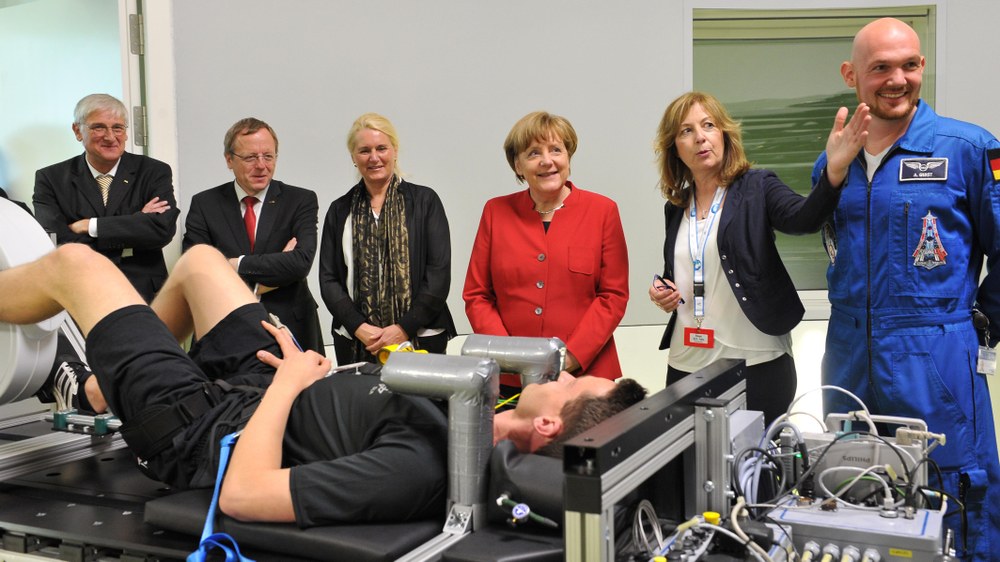Chancellor Angela Merkel visits DLR and ESA in Cologne

Announcement: Alexander Gerst will head to space as Commander of the ISS in 2018
Chancellor Angela Merkel visited the German Aerospace Center (Deutsches Zentrum für Luft- und Raumfahrt; DLR) and the European Space Agency (ESA) European Astronaut Centre (EAC) in Cologne on 18 May 2016. The Chancellor was invited by German ESA astronaut Alexander Gerst and learned about the European Rosetta comet mission, the DLR_School_Lab and the research and training facilities for astronauts at the medical research facility ':envihab' of the DLR Institute of Aerospace Medicine and the EAC. During the Chancellor's visit, ESA Director General Jan Wörner announced that Alexander Gerst has been selected for a second long-term mission on board the International Space Station.
Second flight into space for Alexander Gerst
During the Chancellor's visit, ESA Director General Jan Wörner announced that European astronaut Alexander Gerst is set to spend six months on the International Space Station, from May to November 2018. During the second half of his long-term mission, Gerst will take command of the ISS for three months. "I am delighted with the nomination of German ESA astronaut Alexander Gerst as a member of this international crew and appointment as Commander during his second long-term mission to the ISS in 2018. This mission will enable Germany to further increase its knowledge of space, explained Pascale Ehrenfreund, Chair of the DLR Executive Board. "Space opens up a variety of entirely new or significantly improved applications that can be used to solve global challenges and contribute to strengthening and expanding Germany's long-term competitiveness. After all, if you can travel to space, you can do anything."
Gerst will be the first German ESA astronaut to be appointed as Commander of the ISS and will take over the helm from his fellow European, Belgian Frank de Winne. This will be Gerst's second long-term mission in space after his previous mission from May to November 2014 on the ISS. "Alexander Gerst distinguished himself during his first Blue Dot ISS mission with excellent overall performance and a high level of scientific professionalism. Moreover, he has demonstrated excellent coordination and social skills when interacting with colleagues in the ISS crew," commented Jan Wörner. "For these reasons, ESA selected Gerst for this mission and proposed him as commander of the ISS." The proposal was adopted by the ISS Multilateral Crew Operations Panel (MCOP), the international body responsible for selecting ISS crews.
Visit to the Philae Lander Control Center at DLR
German Chancellor Angela Merkel learned more about the European Rosetta comet mission at the Philae Lander Control Center (LCC). After a 10-year journey through space, ESA's Rosetta spacecraft reached its target comet 67P/Churyumov-Gerasimenko in the spring of 2014. The exploration probe Philae, carried by Rosetta, landed on the comet on 12 November 2014 and explored its mysterious surface. The lander and its instruments were controlled from the Lander Control Center at DLR, where the telemetry of the lander and measurement data from its instruments were also received and analysed. The scientific data transmitted back to Earth during its short life provided scientists with many new insights into comets and their importance in the development of the Solar System. The Rosetta mother probe is also due to 'land' on the comet nucleus, not far from Philae, at the end of the mission in September 2016.
Meeting with young researchers at the DLR_School_Lab
The Chancellor spent a long time visiting the DLR_School_Labsin Cologne. School groups spend a full day each at one of the 12 DLR_School_Labs across Germany, conducting supervised experiments in the vast laboratories and independently discovering the fascinating world of research. Along with sixth grade students from Bonner Gymnasium, the Doctor in Physics watched how water behaves in a drop tower during a brief moment of weightlessness. She also examined an artificial comet with the students. This was created by creating a 'dirty snowball' using nitrogen in a vacuum chamber and exposing it to the radiation of an 'artificial' Sun, a 1200-watt stage light. Due to heat energy, the ice sublimates. During this process, it pulls dust from the surface with it, forming the comet's tail.
Training for space at the :envihab research building
The Chancellor was able to learn about research on the adverse effects of weightlessness and the development of effective training methods for astronauts in the ':envihab' facility of the DLR Institute of Aerospace Medicine. Before and after their stay on the ISS, ESA astronauts go through extensive medical examinations and recovery programmes here. The knowledge gained during these processes is also used for treatments on Earth.


